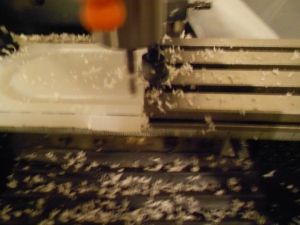This weekend I milled (or attempted to) my first mold. I started by taking measurements of the tuning slide on my trumpet on Thursday. I found that it has a diameter of 0.5000″. The slide length is 2.9475″, the overall length is 4.65″, and the distance between the centers of the slide tubes is 2.641″. This means that it is a slightly flattened arc.
I designed this in Autodesk Inventor on Thursday afternoon and on Friday. I started by designing the tube and then I created a 0.5″ thick block of plastic and subtracted the tube from the block, giving me the design of the mold. This way I can create and adjust the design of the tube and the mold design will be adjusted mostly automatically.
It took many hours on Friday and Saturday to create the toolpath for the part. There are so many parameters to play with and it takes a lot of effort and experience to get the right balance between part quality and short machining time. The first time I created the toolpath I thought I had everything figured out, so I loaded it up into the machine controller and it said it would take over 9 hours to machine. This is obviously far too long to let my machine run unattended. So I had to adjust some settings that will ultimately shorten the machining time and slightly lower the quality of the part.
Here’s the thing about hobbyist machining equipment: The cost of very high quality hardware is very low, but the cost of high quality software is astronomical. The hardware in my machine costs about $2000. There’s some hobbyist software for creating toolpaths (CAM software) that costs between $150 and $500, but if those packages are extremely limited. To get the quality that I need with a reasonable machining time, I would have to spend $2000. Here is an article talking about 3D machining methods: http://www.cnccookbook.com/CC3DCAMToolpaths.html
I ended up with a toolpath that would take 45 minutes, which is pretty reasonable. So I cut out a piece of plastic and clamped it down with the nuts that I use to hold down my vise.
This clamping method worked well, up until the end. I wasn’t watching the mill when this happened, but in the last 5-10 minutes of the process I think the mill was trying to move from one end of the tube to the other, which means it tried to go right through the bolt on the right. It tried to go through it, but of course this was a full depth pass so it couldn’t cut through the bolt. It stalled the stepper motors so it couldn’t push it much farther. You can tell that it was in contact with the nut for a bit of time because it has cut marks all around it, which means it was spinning the bolt. This of course ruined the endmill. The nut and bolt should be fine, although they look a bit messed up. This is definitely a learning experience, but it’s a drag because that was a fancy coated carbide endmill that cost about $20 and I don’t have any extras right now.
It wasn’t done with the toolpath, so it continued to try and cut the final few passes, but of course the part was no longer secured to the table so it cut a few large gouges in the part. Other than those gouges and the fact that the toolpath wasn’t finished, it turned out very well. The tool height also wasn’t set correctly because it didn’t cut quite deep enough it places where it should have been done.
To fix the tool height problem, I made a Z axis touch probe that I’ve been meaning to make for a while. It is very much like the one in this video:
It’s just a piece of pcb board with a wire soldered to it. The mill is grounded, so the tool slowly goes down and when it touches the pcb, it pulls the input to ground and the program stops the motion and records the Z height. From what I’ve seen, this is a very accurate and reliable method of getting the Z height. The height of the pcb isn’t very precise so I might make a more accurate probe, but this solution should get me within 0.002″ of the real Z height, which is approaching the accuracy of my machine anyways.
Here’s a few videos of my mill running. The first three are from this mold prototype and the last one is the mill making some music.


